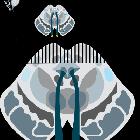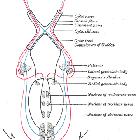Aquäduktsyndrom


Parinaud syndrome, also known as the dorsal midbrain syndrome, is a supranuclear vertical gaze disturbance caused by compression of the superior tectal plate.
Clinical presentation
Parinaud syndrome is characterized by a classic triad of findings:
- upward gaze palsy, often manifesting as diplopia
- pupillary light-near dissociation (pupils respond to near stimuli, but not light)
- convergence-retraction nystagmus
Its importance lies in that recognition of Parinaud syndrome localizes pathology to impingement of or origin in the tectal plate, most frequently due to a posterior commissure or pineal region mass (typically solid tumors rather than pineal cysts).
History and etymology
Named after Henry Parinaud, a French ophthalmologist (1844-1905).
Siehe auch:
und weiter:

 Assoziationen und Differentialdiagnosen zu Aquäduktsyndrom:
Assoziationen und Differentialdiagnosen zu Aquäduktsyndrom:
